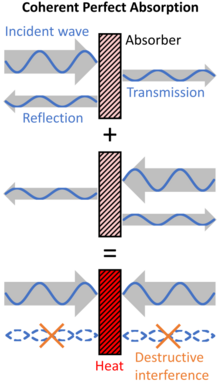A coherent perfect absorber (CPA), or anti-laser, is a device which absorbs coherent waves, such as coherent light waves, and converts them into some form of internal energy, e.g. heat or electrical energy.[1][2] It is the time-reversed counterpart of a laser.[3] Coherent perfect absorption allows control of waves with waves (light with light) without a nonlinear medium. The concept was first published in the July 26, 2010, issue of Physical Review Letters, by a team at Yale University led by theorist A. Douglas Stone and experimental physicist Hui W. Cao.[4][5] In the September 9, 2010, issue of Physical Review A, Stefano Longhi of Polytechnic University of Milan showed how to combine a laser and an anti-laser in a single device.[6] In February 2011 the team at Yale built the first working anti-laser.[7][8] It is a two-channel CPA device which absorbs two beams from the same laser, but only when the beams have the correct phases and amplitudes.[9] The initial device absorbed 99.4 percent of all incoming light, but the team behind the invention believe it will be possible to achieve 99.999 percent.[7] Originally implemented as a Fabry-Pérot cavity that is many wavelengths thick, the optical CPA operates at specific optical frequencies. In January 2012, thin-film CPA has been proposed by utilizing the achromatic dispersion of metal-like materials, exhibiting the unparalleled bandwidth and thin profile advantages.[10] Shortly after, CPA was observed in various thin film materials, including photonic metamaterial,[11] multi-layer graphene,[12] single[13] and multiple[14] layers of chromium, as well as microwave metamaterial.[15]


- ^ Gmachl, Claire F. (2010). "Laser science: Suckers for light". Nature. 467 (7311): 37–39. Bibcode:2010Natur.467...37G. doi:10.1038/467037a. PMID 20811446.
- ^ "Behold, the Antilaser". Science News. Archived from the original on 2012-11-15. Retrieved 2010-09-07.
- ^ Longhi, Stefano (2010). "Backward lasing yields a perfect absorber". Physics. 3: 61. Bibcode:2010PhyOJ...3...61L. doi:10.1103/Physics.3.61.
- ^ Chong, Y.; Ge, Li; Cao, Hui; Stone, A. (2010). "Coherent Perfect Absorbers: Time-Reversed Lasers". Physical Review Letters. 105 (5): 053901. arXiv:1003.4968. Bibcode:2010PhRvL.105e3901C. doi:10.1103/PhysRevLett.105.053901. PMID 20867918. S2CID 17003350.
- ^ Stefano Longhi (2010). "Backward lasing yields a perfect absorber". Physics. 3: 61. Bibcode:2010PhyOJ...3...61L. doi:10.1103/Physics.3.61.
- ^ Stefano Longhi (2010). "PT-symmetric laser absorber". Physical Review A. 82 (3): 031801. arXiv:1008.5298. Bibcode:2010PhRvA..82c1801L. doi:10.1103/PhysRevA.82.031801. S2CID 119157414. (Synopsis by Mark Saffman.)
- ^ a b "Scientists Build the World's First Anti-laser". Yale University. 2011-02-17. Archived from the original on 2011-02-21. Retrieved 2011-02-17.
- ^ "Scientists build the world's first anti-laser". BBC. 2011-02-17. Retrieved 2011-02-17.
- ^ Wan, W.; Chong, Y.; Ge, L.; Noh, H.; Stone, A. D.; Cao, H. (2011). "Time-Reversed Lasing and Interferometric Control of Absorption". Science. 331 (6019): 889–892. Bibcode:2011Sci...331..889W. doi:10.1126/science.1200735. PMID 21330539. S2CID 206531272.
- ^ a b Pu, M.; Feng, Q.; Wang, M.; Hu, C.; Huang, C.; Ma, X.; Zhao, Z.; Wang, C.; Luo, X. (17 January 2012). "Ultrathin broadband nearly perfect absorber with symmetrical coherent illumination". Optics Express. 20 (3): 2246–2254. Bibcode:2012OExpr..20.2246P. doi:10.1364/oe.20.002246. PMID 22330464.
- ^ Zhang, J.; MacDonald, K. F.; Zheludev, N. I. (6 July 2012). "Controlling light-with-light without nonlinearity". Light: Science & Applications. 1: e18. arXiv:1203.6110. doi:10.1038/lsa.2012.18.
- ^ Rao, S. M.; Heitz, J. J. F.; Roger, T.; Westerberg, N.; Faccio, D. (2014). "Coherent control of light interaction with graphene". Optics Letters. 39: 5345–5374. arXiv:1406.6217. doi:10.1364/OL.39.005345.
- ^ Goodarzi, A.; Ghanaatshoar, M. (2016). "Controlling light by light: photonic crystal-based coherent all-optical transistor". Journal of the Optical Society of America B. 33: 1594–1599. doi:10.1364/JOSAB.33.001594.
- ^ Vetlugin, A. N.; Guo, R.; Soci, C.; Zheludev, N. I. (2022). "Deterministic generation of entanglement in a quantum network by coherent absorption of a single photon". Physical Review A. 106: 012402. doi:10.1103/PhysRevA.106.012402. hdl:10356/170804.
- ^ Li, S.; Luo, J.; Anwar, S.; Li, S.; Lu, W.; Hang, Z.H.; Lai, Y.; Hou, B.; Shen, M.; Wang, C. (2015). "Broadband Perfect Absorption of Ultrathin Conductive Films with Coherent Illumination: Super Performance of Electromagnetic Absorption". Physical Review B. 91 (22): 220301. arXiv:1406.1847. Bibcode:2015PhRvB..91v0301L. doi:10.1103/PhysRevB.91.220301. S2CID 118609773.